Defenses for Fall 2017
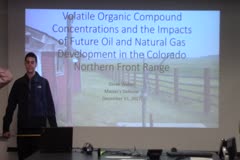
Volatile Organic Compound Concentrations and the Impacts of Future Oil and Natural Gas Development in the Colorado Northern Front Range
December 15, 2017
Derek Weber
Recent advances in unconventional extraction of oil and natural gas (O&NG) have caused an increase in the number of wells in the Colorado Northern Front Range (CNFR) which has doubled Colorado’s natural gas production over the last 15 years. Increased O&NG activity can lead to increased emissions of Volatile Organic Compounds (VOCs) which may negatively impact air quality and human…
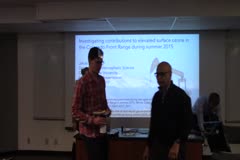
Investigating Contributions to Elevated Surface Ozone in the Colorado Front Range During Summer 2015
December 08, 2017
Jakob Lindaas
Tropospheric ozone (O3) is a significant pollutant in the Colorado Front Range. The northern Front Range metropolitan area (NFRMA) has exceeded the U.S. EPA national ambient air quality standard for O3 since 2008. While many regions in the country have experienced downward trends in ground-level O3, the NFRMA O3 mixing ratios have remained stagnant…
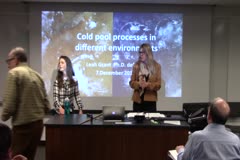
Cold Pool Processes in Different Environments
December 07, 2017
Leah Grant
Cold pools are localized regions of dense air near Earth’s surface. They form in association with precipitating clouds in many environments ranging from moist tropical to semi-arid continental conditions, and they play important roles in weather in climate. The overarching goal of this dissertation research is to improve our process-level understanding of cold pool interactions with…
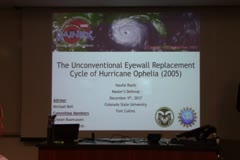
The Unconventional Eyewall Replacement Cycle of Hurricane Ophelia (2005)
December 05, 2017
Naufal Razin
One of the mechanisms proposed for the spin-up of the tropical cyclone (TC) mean tangential circulation is the convergence of absolute angular momentum above the boundary layer. This mechanism is important for the outer primary circulation and results in the broadening of the TC wind field. We hypothesize that the mid-level inflow associated with the stratiform precipitation in TC rainbands may…
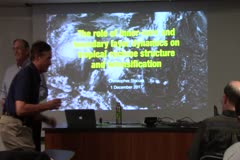
The role of inner-core and boundary layer dynamics on tropical cyclone structure and intensification
December 01, 2017
Christopher Slocum
Inner-core and boundary layer dynamics are vital to the tropical cyclone life cycle. This study makes use of analytical solutions and numerical models to glean insight into the role of certain processes involved with the incipient, rapidly intensifying, and eyewall replacement stages. We develop a simplified, axisymmetric, one-layer, analytical model of tropical cyclone intensification. This…
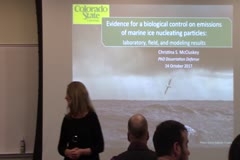
Evidence for a Biological Control on Emissions of Marine Ice Nucleating Particles: Laboratory, Field and Modeling Results
October 24, 2017
Christina McCluskey
Numerical models poorly represent cloud phase (liquid or ice) partitioning in high latitude regions, resulting in uncertainties in climate sensitivity estimates. Over the last decade, new observations have revealed that supercooled liquid clouds are unexpectedly abundant over the Southern Ocean, compared with midlatitudes, leading to large hemispheric biases in radiation budget estimates in…
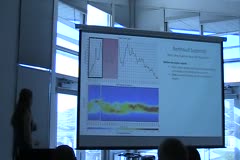
AN ANALYSIS OF TOTAL LIGHTNING CHARACTERISTICS IN TORNADIC STORMS: PREPARING FOR THE CAPABILITIES OF THE GLM
October 06, 2017
Karly Reimel
Numerous studies have found that severe weather is often preceded by a rapid increase in the total lightning flash rate. This rapid increase results from numerous intra-cloud flashes forming around the periphery of an intensifying updraft. The relationship between flash rates and updraft intensity is extremely useful to forecasters in severe weather warning decision making processes, but…
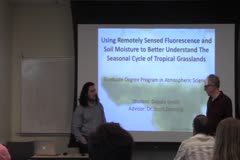
Using Remotely Sensed Fluorescence and Soil Moisture to Better Understand the Seasonal Cycle of Tropical Grasslands
September 01, 2017
Dakota Smith
Seasonal grasslands account for a large area of Earth's land cover. Annual and seasonal changes in these grasslands have profound impacts on EarthÂ’s carbon, energy, and water cycles. In tropical grasslands, growth is commonly water-limited and the landscape oscillates between highly productive and unproductive. As the monsoon begins, soils moisten providing dry grasses the water necessary…
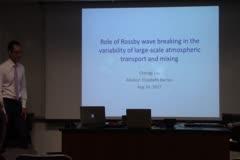
Role of Rossby wave breaking in the variability of large-scale atmospheric transport and mixing
August 24, 2017
Chengji Liu
We demonstrate that Rossby wave breaking (RWB) plays an important role in both horizontal and vertical large-scale transport/mixing in both observations and idealized general circulation models. In the horizontal direction, RWB contributes to a substantial fraction of transient moisture flux into the Arctic. In the vertical direction, RWB modifies thermal stratification near the tropopause…
